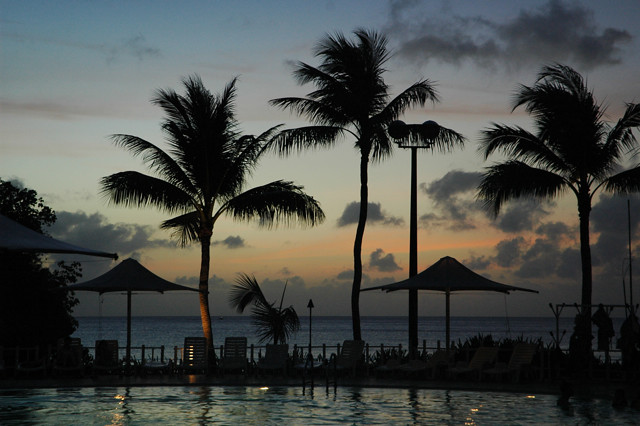My aunt Shannon’s published obituary of my grandfather Joe Murphy, who died as I was en route to my other grandfather’s death bed. Two deaths in one day, on opposite sides of the earth. Yikes. Grandpa Joe, being a Murphy, won this particular race.
Joseph Charles Murphy, born Feb. 23, 1927, in Appleton, Wisc., died at the age of 81 yesterday at his home in Yona, Guam. He had been ill for the past month with pneumonia, complicated by diabetes and heart disease.
He died in his sleep at his home above the Ylig Bay in Yona, just as he had wished.
He is survived by his wife, Marion Murphy, seven children, 25 grandchildren and 17 great grandchildren. His children are Colleen, Maureen, Shannon, Timothy, Erin, Megan and Joey. One daughter, Kerry, predeceases him. Many of his children live in Guam, while others live in Oregon, California and Texas. He was a father figure to many other youth who came into the Murphy household, one way or another.
Murphy grew up in a small town in Wisconsin, joining the Navy at age 17 during World War II. He met Marion when he was on home leave, as they were from the same town. They wrote to each other for a year, and then World War II was over and he went home to finish high school with her. They eloped on the night of their high school graduation and were married for 62 years.
He earned a degree in journalism from the University of Wisconsin at Madison and worked as a journalist ever since. Murphy worked as a reporter, editor and columnist in Wisconsin, Oregon and California before taking a job in Guam in 1965.
Murphy arrived on Guam Dec. 8, 1965, which is Our Lady of Kamalen Day, celebrated with a procession through Hagåtña. He always joked that at first he thought that procession was a welcoming parade just for him.
After relocating his large family here a few months later, he said he had found his place in the world, as everyone had large Catholic families, just like him.
Guam was good to him. At first he ran the then-Guam Daily News, owned at the time by Publisher Joe Flores, pretty much by himself. He covered local news and wrote editorials and the daily column “Pipe Dreams” and put together the national and international news seven days a week.
A businessman from Hawaii, Chin Ho, bought the paper in 1970 and then resold it to Gannett Inc. a year later. With a new, larger staff, Murphy became the editor, continuing to write his daily “Pipe Dreams” column and a daily editorial.
He documented the early days of tourism, watching Guam change from a sleepy military outpost with a population of about 60,000 to an international tourist destination with a population of 165,000 today. He loved to write about new development, the economy, innovative ideas and politics. In 1981, the Daily News gave him a year to travel around the Pacific and write about other islands.
He coined the phase “Only on Guam” as an occasional item in his column — poking fun at the idiosyncrasies that make Guam such an interesting and unique place in which to live. Those “items” were published into two books: “Guam is a Four Letter Word” and “Son of a Four Letter Word.”
Murphy loved adventure and took advantage of offers to try things and write about them. One Liberation Day, he parachuted from a helicopter on a bet, breaking his leg in the process. He went to the depths of the sea on a Navy submarine ride and rolled and dived with the Blue Angels and on the Christmas Drop to Micronesia. He also traveled by ship or on small planes to many islands in Micronesia for graduations and other news events.
Murphy retired as editor of the Pacific Daily News in 1988, but continued to write his column, which changed names from “Pipe Dreams” to “Murphy’s Law” after he quit smoking.
He and his wife, Marion, traveled the world. After raising their children, the Murphys went to China the first year it was open to Westerners, to Europe and Asia, traveling around the world at least twice. He loved to learn about history, geography, culture and politics, always looking for new ideas that might work on Guam, his beloved home, and shared those thoughts in his column in the Pacific Daily News.
He was a great believer in equality, pushing his daughters as well as his sons to find their passions and excel in life. He thought highly of island peoples as well. He and his wife passed their attitudes about islanders to their children, and they now have dozens of grandchildren and great grandchildren of Chamorro, Filipino, Palauan and Chuukese decent.
Murphy always kept a pen and paper with him to jot down notes for his column and wanted to write until the end. He left a legacy of writers, both among his own children, grandchildren and great grandchildren, and many others who were inspired by his words and actions to become journalists.
Shannon Murphy is a former editor of the Pacific Daily News and daughter of Joseph Murphy
[From Murphy documented Guam | guampdn.com | Pacific Daily News]
My plan is to go to Guam in March to visit and mourn and celebrate my grandmother’s 80th birthday, but have a minor issue with getting a passport still.












